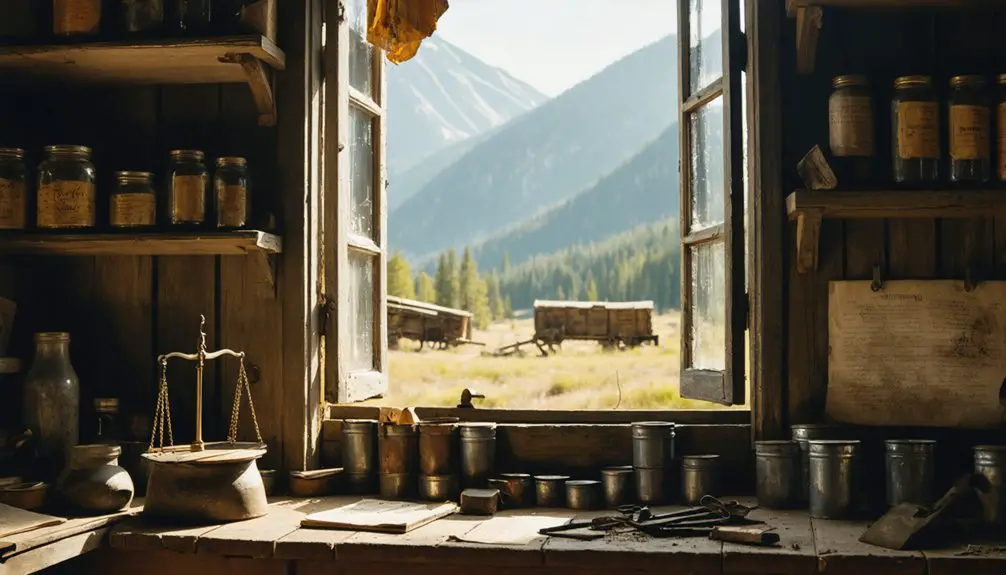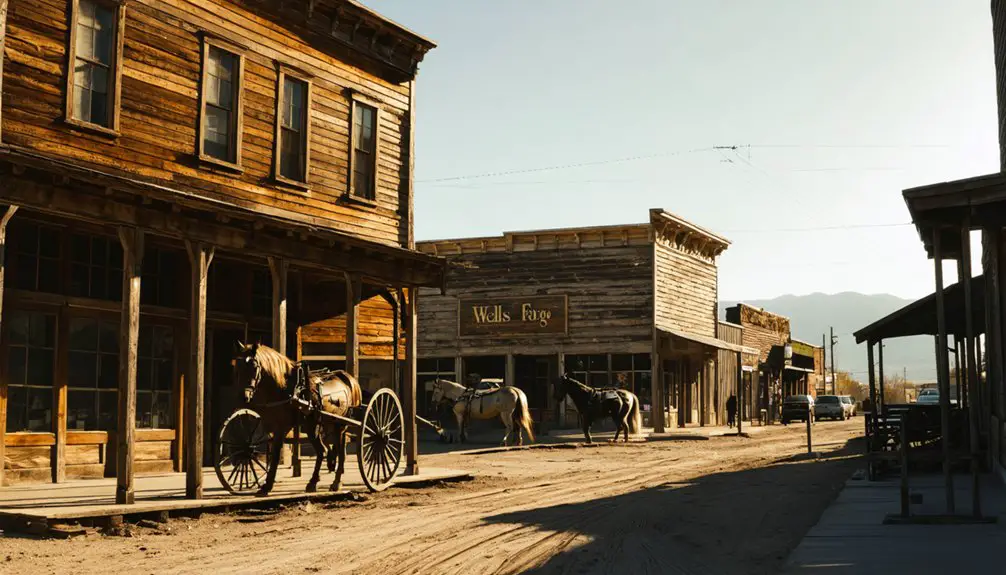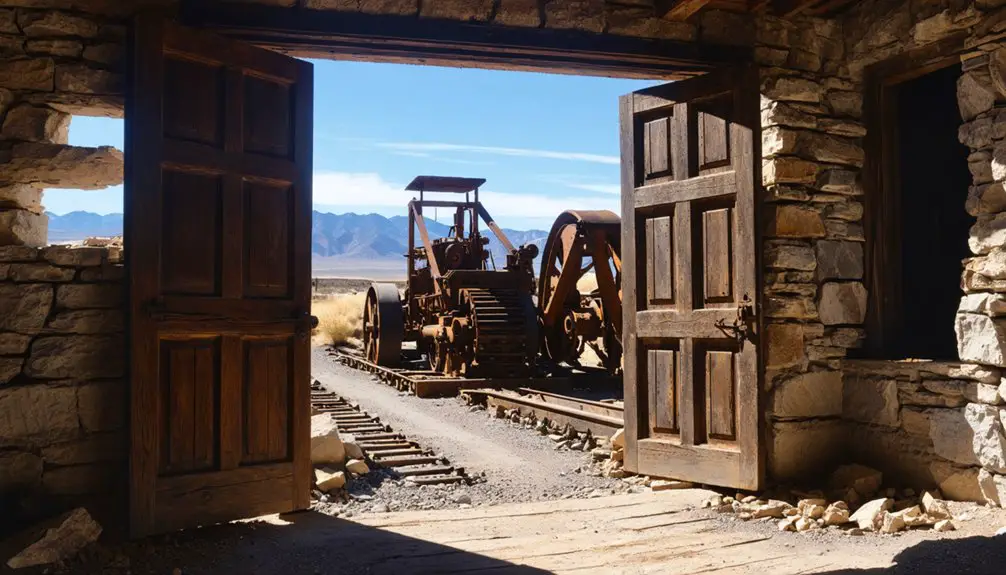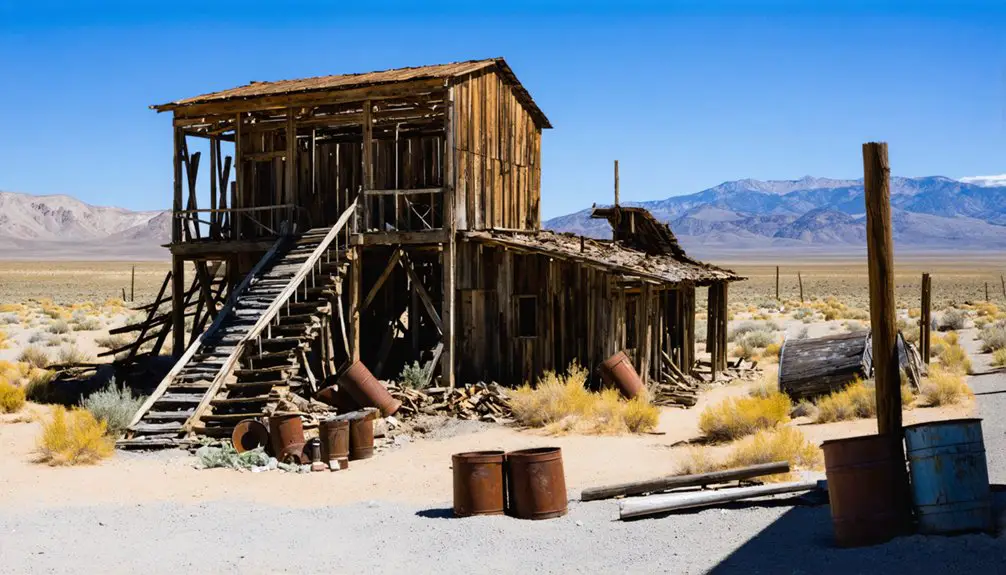You’ll find Hamilton’s ghost town ruins at high elevation in Nevada, where a phenomenal silver discovery in 1867 transformed a cave settlement into a bustling city of 12,000 residents. The town boasted 200 mining operations, 100 saloons, and numerous businesses during its peak years of 1868-1869. Two devastating fires in 1873 and 1885, combined with depleted silver deposits, led to Hamilton’s abandonment. Today’s crumbling structures tell a compelling story of boom-to-bust Western ambition.
Key Takeaways
- Hamilton was a silver mining boomtown in Nevada that grew from 5,000 to 12,000 residents between 1868-1869 before becoming a ghost town.
- Located at high elevations between 8,000-10,500 feet, early settlers lived in caves before building a thriving town with 200 mining operations.
- The town featured nearly 100 saloons, 60 general stores, theaters, and banks during its peak as a commercial and mining center.
- Two devastating fires in 1873 and 1885, combined with depleted silver deposits, led to Hamilton’s rapid decline and abandonment.
- Today, Hamilton’s ruins are preserved and monitored by conservation groups as a testament to Nevada’s silver mining heritage.
The Birth of a Silver Boomtown
How did a remote mountain location in Nevada become one of the West’s most explosive silver boomtowns? It started in 1867 when prospectors discovered rich silver deposits at Treasure Hill.
Within just one year, you’d find 5,000 people drawn to what was initially called Cave City, as early settlers took shelter in natural caves while building their community.
The discovery sparked a remarkable transformation. By 1869, the population exploded to 10,000-12,000 as silver mining operations expanded across the White Pine district. The forty-foot-wide vein of silver ore helped drive this explosive growth.
The boom was meteoric – within months, thousands flooded the district as silver fever gripped the West’s newest frontier.
The town infrastructure rapidly evolved from primitive shelters to a bustling city named Hamilton, complete with over 50 general stores, nine assay offices, and 100 saloons. For clarity in historical records, the settlement was officially listed as Hamilton disambiguation page to distinguish it from other locations sharing the name.
Miners moved eastward from established camps like Virginia City, attracted by the exceptionally pure silver ore that would reshape this high-elevation frontier.
Life at High Altitude: Cave City to Hamilton
If you’d visited Hamilton’s earliest settlers, you’d have found them living in natural caves around Cave City, where they sought protection from harsh mountain conditions at over 10,000 feet elevation.
As the population grew and mining operations expanded, residents shifted from these cave dwellings to constructed buildings, using local materials like stone and timber to create structures better suited for year-round habitation. Located in White Pine County, this remote mining settlement faced significant logistical challenges in obtaining supplies and maintaining connections with other communities. Regular updates to their geographic information systems helped miners navigate the challenging terrain more effectively.
Life at this altitude presented unique challenges for miners and residents alike, who’d to adapt to thinner air, extreme weather, and limited growing seasons while pursuing their silver mining ambitions.
Early Cave Dwellers
When silver prospectors first arrived in Hamilton during 1868, they found immediate shelter in the numerous caves dotting Treasure Hill‘s rugged landscape at elevations between 8,000 and 10,500 feet.
These cave adaptations, similar to indigenous influences from the Northern Paiute (Numu), allowed nearly 10,000 people to survive the harsh mountain environment before permanent structures were built.
Archaeological surveys have revealed an almost complete absence of artifacts at many of these cave sites, making their exact historical usage challenging to determine.
The settlers who established themselves in caves and huts would later witness Hamilton’s rapid growth into a thriving town with a main street and businesses.
- Natural protection from extreme weather conditions
- Stable living spaces at challenging high altitudes
- Proximity to silver mining operations
- Access to hunting and gathering grounds
- Community formation in cave networks
You’ll find evidence of this cave-dwelling period in the Hamilton Family Archaeological Preserve, where 75-100 conical pits show both prehistoric Native American usage and settler occupation.
This unique settlement pattern demonstrates how the rush for silver drove people to adapt to extreme conditions using natural shelters.
From Caves to Buildings
The rapid evolution from primitive cave shelters to a bustling frontier town marked Hamilton’s meteoric rise in 1868-1869.
You’d find early settlers living in makeshift dwellings – caves, tents, and hay bale huts – as they sought mining sustenance at elevations between 8,000 to 10,500 feet.
Cave architecture quickly gave way to permanent structures after Hamilton’s incorporation, transforming the landscape with banks, churches, and nearly 200 mining operations.
Sadly, a devastating fire in 1873 destroyed much of the town’s main district.
By 1867, the early mining boom brought a surge of over 10,000 people to this remote mountain settlement.
High-Altitude Mining Life
Life at Hamilton’s dizzying elevation of 8,000 to 10,500 feet presented unique challenges for its burgeoning population of 10,000 to 12,000 residents during the peak silver rush years of 1868-1869.
Despite harsh conditions, the town’s cultural resilience and mining innovation transformed a cave-dwelling settlement into a thriving high-altitude community.
- You’d find extraordinary silver ore values up to $15,000 per ton, surpassing the famous Comstock Lode.
- Your entertainment options included nearly 100 saloons, theaters, dance halls, and skating rinks.
- You could join active miners’ unions and fraternal organizations, fostering community bonds.
- You’d experience the convenience of 60 general stores serving daily needs.
- You’d benefit from ambitious infrastructure projects, including a $400,000 water system.
The demanding environment couldn’t suppress the determined spirit of Hamilton’s residents, who built a remarkable civilization amid the thin mountain air.
Two devastating major fires in 1873 and 1885 accelerated the town’s eventual decline.
The prosperity was short-lived, as the town’s population plummeted to just 500 by 1873 amid failing mines and depleted ore bodies.
Silver Mining Operations and Challenges
Following discovery of rich silver deposits on Treasure Hill in 1867, Hamilton’s mining operations expanded rapidly into one of Nevada’s most promising ventures.
With ore assays reaching $15,000 per ton – triple the Comstock Lode’s peak values – nearly 200 mining companies flocked to the area by 1869, supporting a population of 10,000-12,000 residents.
Hamilton’s explosive growth drew hundreds of mining operations after silver assays tripled the Comstock’s richest finds, creating a bustling 12,000-person boomtown.
Mining techniques initially targeted bonanza silver ores using gravity-fed mills, but ore processing challenges quickly emerged.
You’ll find that while the Belmont Mill represented state-of-the-art technology for lead-silver processing by 1926, operational inefficiencies and declining ore quality plagued the district.
The high-altitude environment (8,000-10,500 feet) complicated mining logistics, while water supply demands required $400,000 in infrastructure investments.
These challenges, combined with fluctuating silver prices, ultimately led to the operation’s decline.
Daily Life in a Thriving Mining Community

You’d find Hamilton’s daily life centered around its numerous entertainment venues, including 100 saloons, theaters, dance halls, and skating rinks that served the social needs of miners and residents.
The town’s commercial vigor was evident in its 60 general stores, nine assay offices, and 29 attorneys, reflecting the complex business ecosystem that emerged to support mining operations.
The Miners’ Union Hall and fraternal organizations played vital roles in workers’ lives, providing spaces for labor organization, mutual aid, and community bonding in this high-altitude boomtown.
Entertainment and Leisure Activities
Despite the harsh realities of frontier mining life, Hamilton’s residents enjoyed a surprisingly rich variety of entertainment options at the town’s peak.
The town’s nearly 100 saloons, theaters, and dance halls served as hubs for local gatherings and recreational activities, offering escape from the demanding work in the mines.
You’d find plenty of ways to spend your leisure time:
- Catch live performances at multiple theaters staging plays and shows
- Join public dances with live music at the town’s bustling dance halls
- Visit skating rinks for physical recreation and social interaction
- Participate in fraternal order events at the Miners’ Union Hall
- Enjoy drinks and socializing at any of the numerous saloons
These entertainment venues, supported by local breweries and an active social scene, helped build a vibrant community despite the challenging mountain environment at 8,000-10,500 feet elevation.
Business and Commerce Growth
While miners and residents enjoyed Hamilton’s lively entertainment scene, the town’s rapid evolution into a commercial powerhouse defined its peak years.
You’d find an impressive array of businesses catering to every need, with 60 general stores, 100 saloons, and multiple banking institutions supporting the booming economy. As the population exploded from 600 to over 10,000 residents, economic diversification became essential, spawning opportunities beyond mining.
Hamilton’s designation as county seat strengthened its commercial dominance, while mining legislation helped regulate the 200 operating mining companies.
The arrival of the Transcontinental Railroad in 1869 revolutionized supply chains, and major infrastructure projects like the $400,000 water system demonstrated the town’s commitment to growth.
You’ll notice how Hamilton’s strategic location made it the preferred hub over neighboring settlements.
Mining Workers’ Social Life
As miners flocked to Hamilton during its heyday, a vibrant social ecosystem emerged to support their daily lives beyond the demanding work in the mines. You’d find numerous venues for social gatherings, from nearly 100 saloons to theaters and dance halls, creating spaces where workers could unwind and build community cohesion.
- The Miners’ Union Hall served as a hub for labor solidarity and community events.
- Local breweries and saloons offered popular spots for after-work socializing.
- Skating rinks and dance halls provided family-friendly entertainment options.
- Fraternal orders fostered strong social networks among workers.
- Churches and schools supported the growing families of miners.
From humble beginnings in caves and huts, Hamilton’s social scene evolved into a sophisticated network of institutions that balanced the rigorous demands of mining life with recreational opportunities.
The Peak Years: 1868-1869

Following the discovery of silver ore on Treasure Hill in 1867, Hamilton rapidly transformed from a makeshift settlement into a bustling boomtown of 12,000 residents by summer 1869.
You’d find miners working an unusually large silver deposit, just 28 feet below the surface, that measured 40 feet wide and 70 feet long. The unprecedented rush led to nearly 200 mining companies operating in the area, generating about one million dollars in silver production.
The town’s explosive growth brought remarkable development. You could walk down a main street lined with 60 general stores, almost 100 saloons, and numerous entertainment venues.
Despite the harsh conditions at elevations up to 10,500 feet, where early settlers lived in caves and makeshift shelters, Hamilton quickly established itself as White Pine County‘s first seat in 1869.
Business and Entertainment in Hamilton
The explosive growth of Hamilton’s population demanded a robust commercial infrastructure to meet residents’ needs.
You’d find evidence of economic resilience in the town’s diverse business landscape, which fostered strong community cohesion through various social venues and commercial enterprises.
- Over 60 general stores supplied essential goods while numerous breweries served the town’s 100+ saloons
- Entertainment venues included theaters, dance halls, and skating rinks
- Financial institutions and specialized services supported the mining industry
- The Miners’ Union Hall served as a central gathering point for worker organization
- Fraternal orders and social clubs created structured networks for civic engagement
This vibrant mix of commerce and entertainment transformed Hamilton from a mere mining camp into a full-service frontier town, where you could find everything from banking services to tailored clothing, gunsmith shops to theatrical performances.
Natural Resources and Mining Technology

Mining operations in Hamilton centered around the rich silver deposits of Treasure Hill, where prospectors discovered an exceptionally concentrated vein in 1867 measuring 40 feet wide, 70 feet long, and 28 feet below the surface.
The shallow deposits allowed for straightforward mining techniques, and you’ll find evidence of early miners using basic extraction methods from caves and primitive settlements at elevations between 8,000 and 10,500 feet.
Nearly 200 mining companies staked claims during the peak years of 1868-1870, processing ore through stamp mills and generating impressive yields worth $1 million in 1869 dollars.
The silver rush transformed Hamilton into a boomtown, with hundreds of mining operations generating massive wealth through stamp mill processing.
However, the economic volatility of silver mining became apparent as surface deposits depleted and technological limitations prevented deeper extraction. Combined with devastating fires in 1873 and 1885, these challenges led to Hamilton’s rapid decline.
The Great Fires and Town’s Decline
Devastating fires in 1873 and 1885 dealt fatal blows to Hamilton’s prosperity, marking crucial turning points in the town’s rapid decline.
The fire impact crushed the town’s thriving business district, and with minimal rebuilding efforts, you’ll understand why Hamilton’s population decline was swift and irreversible.
Key effects of these catastrophic fires include:
- Population plummeted from 12,000 to 6,800 after the 1873 fire
- Destruction of over 200 mining company operations
- Loss of the courthouse and essential county records in 1885
- Relocation of the county seat to Ely
- Abandonment of most structures by the late 1880s
Today, you’ll find only scattered ruins where this once-bustling silver mining town stood, with the brick Wells Fargo building standing as a lonely sentinel to Hamilton’s fiery demise.
Modern-Day Ghost Town Exploration

Exploring Hamilton’s ghost town today requires careful preparation and adherence to safety protocols, as visitors must navigate challenging terrain and numerous hazards.
You’ll need to equip yourself with protective gear, GPS devices, and offline maps to safely explore the site’s unstable structures and avoid dangerous mine shafts.
Modern urban exploration techniques have revolutionized how you can document and share Hamilton’s history. Using drones, digital cameras, and GPS-tagged photos, you’re able to capture and preserve the site’s current condition while maintaining ghost town preservation standards.
Advanced technology lets explorers document Hamilton’s ghost town in unprecedented detail while respecting preservation guidelines.
You’ll find online communities sharing real-time updates about site conditions and access requirements. Remember that some areas may require permits or lie on private property, so it’s crucial to research legal restrictions before your visit.
Local conservation groups actively monitor the site to protect its historical legacy.
Legacy of Nevada’s Silver Rush Era
When you explore Hamilton’s ghost town ruins today, you’ll find the enduring remnants of Nevada’s explosive 1860s silver rush that transformed remote mountain settlements into thriving communities.
The town’s rapid rise and eventual decline mirrors the broader pattern of Nevada’s silver-mining settlements, where initial mineral wealth sparked dramatic population growth and infrastructure development before the inevitable bust.
The crumbling stone buildings and abandoned mine shafts you’ll encounter serve as tangible links to an era that fundamentally shaped Nevada’s economic and cultural identity.
Booming Growth and Demise
Following the discovery of silver ore at Treasure Hill in January 1867, Hamilton emerged as one of Nevada’s most spectacular boom-and-bust stories during the silver rush era.
The discovery’s cultural impact and economic transformation reshaped the region as thousands rushed to stake their claims in the White Pine mining district.
- Population exploded from zero to 12,000 residents in just two years
- Over 200 mining companies operated during peak production
- Town boasted 100 saloons and 60 general stores by 1869
- $400,000 water project planned to serve up to 50,000 people
- Silver ore assayed at an astounding $15,000 per ton
- https://travelnevada.com/ghost-town/hamilton-ghost-town/
- https://en.wikipedia.org/wiki/Hamilton
- https://nevadamagazine.com/issue/july-august-2016/3558/
- https://shpo.nv.gov/nevadas-historical-markers/historical-markers/hamilton
- https://westernmininghistory.com/towns/nevada/hamilton/
- https://coloradosghosttowns.com/Hamilton NV.html
- https://elevation.maplogs.com/poi/mount_hamilton_mt_hamilton_nevada_usa.3806.html
- https://edits.nationalmap.gov/apps/gaz-domestic/public/gaz-record/859931
- https://peakvisor.com/peak/mount-hamilton-d21z1jyd.html
- https://peakery.com/mount-hamilton-nevada/
You’ll find Hamilton’s dramatic decline was just as swift as its rise.
Two devastating fires in 1873 and 1885, coupled with depleted silver deposits, transformed this once-thriving metropolis into a ghost town, ending its brief reign as White Pine County’s seat.
Rich Heritage Still Stands
Hamilton’s rich heritage lives on through its remarkable remnants of Nevada’s Silver Rush era.
You’ll find evidence of its cultural significance in the preserved ruins, including the $55,000 courthouse that once symbolized the town’s civic pride. The ambitious water projects, designed for 50,000 residents, showcase the boundless optimism of frontier development.
While fires ravaged much of Hamilton’s original infrastructure, the U.S. Forest Service’s preservation efforts in the 2000s have stabilized key historical structures.
The site stands as a tribute to Nevada’s mining heritage, from its 200 mining companies to its vibrant social scene of theaters and saloons. The 1926 Belmont Mill, though short-lived, represents the persistent spirit of mining innovation that defined this remarkable chapter in Western history.
Frequently Asked Questions
What Was the Average Temperature and Climate in Hamilton During Mining Years?
You’d experience harsh climate patterns with 10-month winters and brief summers at 8,000+ feet elevation. Temperature fluctuations were extreme, from freezing winters to mild summer days and cool nights.
Were There Any Notable Crimes or Outlaws Associated With Hamilton?
You won’t find famous outlaws specifically tied to Hamilton, though criminal activities were common – typical mining town disorder with saloon brawls, claim disputes, and petty crimes marked the boom years.
How Did Miners Transport Silver From Hamilton’s Remote Mountain Location?
You’ll find they moved silver primarily by aerial tramway, spanning three miles over rugged terrain. The diesel-powered system transported ore buckets from mountain mines directly to Belmont Mill for processing.
What Happened to Hamilton’s Residents After the Town’s Decline?
You’ll find the residents dispersed to future settlements like Ely, seeking better economic prospects after Hamilton’s mining decline. Many moved to railroad-accessible towns while others followed new mining opportunities elsewhere.
Are There Any Paranormal Activities Reported at Hamilton’s Ghost Town Site?
While you might expect ghost sightings in such a historic setting, there aren’t any documented paranormal activities or haunted locations at Hamilton’s site, unlike other Nevada ghost towns with established supernatural claims.



